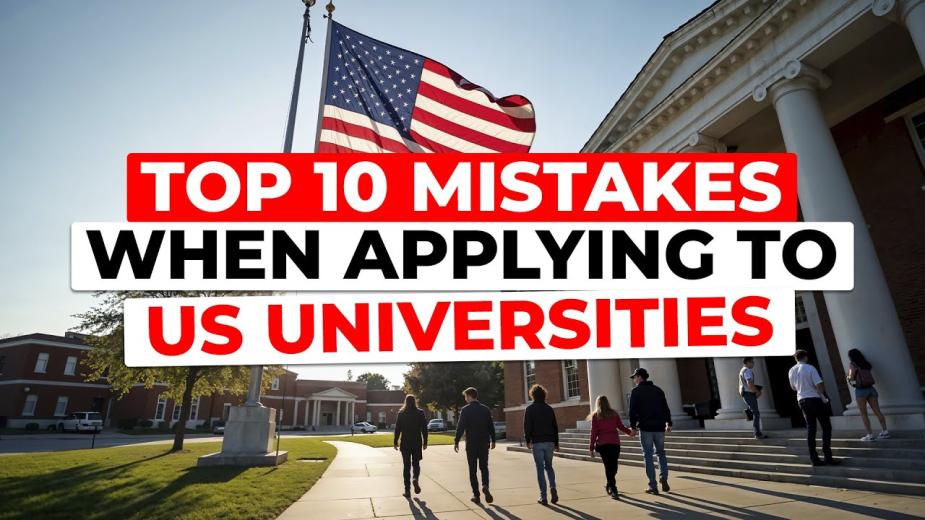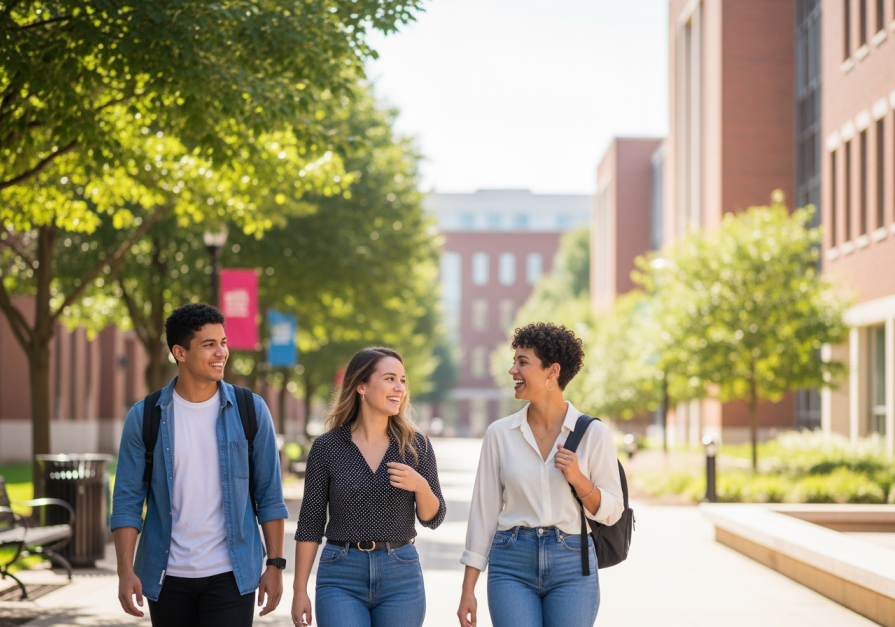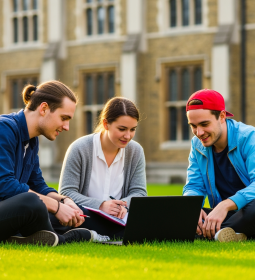More foreign students study at American colleges and universities than in any country in the world. Today in USA about 600,000 people from different countries are studying. The choice of students is due to several reasons. One of the main - a huge selection of training programs. They are offered in the States more than 1000. American training programs are diverse. Some are time and practice tested, others are innovative, others are unique, etc. Foreign students appreciate the powerful scientific base of the USA. Universities here are not just educational institutions. Each has its own research center, where advanced technologies are developed in various fields of knowledge.

- Territory - 9.36 million square meters. Km
- Population - 304.2 million people
- Capital - Washington, DC (population - 588.3 thousand people)
- Language - English [999.8 ]
- Currency - the dollar (USD)
The reputation of the teaching, professorship also plays a role. Students in the country are taught not just professionals in a particular field of activity. Teaching in universities, people who have made any discovery, created the author's methodology, etc. American universities are notable for their wealth of libraries. Especially it concerns electronic resources. The diploma obtained in the country is quoted in most countries of the world.
Higher education in the United States
In the United States, a multi-level educational model is being implemented. It involves cycle training. The first cycle (undergraduate) is a four-year cycle, and ends with assigning a bachelor's degree to the student. The training includes about 30 disciplines. The level of knowledge on each of them is assessed by credits. Passing point for obtaining a bachelor's degree is 120 credits. Estimates are earned in the traditional way: listening to lectures, attending practical classes, performing laboratory work, handing over independent work (report, essay, essay, etc.).
The learning system in America is flexible enough. In the first years of study, students master basic disciplines. The last 2 courses provide for the choice of priority subjects from the extensive list offered by the college or university. To move to the next educational level, students collect credits and deduce the Graduate Point Average on the average score to the required level.
Master in the States is called graduate. At this stage, students study for 2 years. The programs presuppose specialization in the areas chosen in the bachelor's program. At the end of the course, students defend their master's thesis. In America, there is a narrow specialization of students. It is available through the Professional School program. The result of training is the degree of Advanced Professional Degree.

The US education system crowns the doctorate. It is designed for 3-4 years. The analogue of this stage is postgraduate study. At the end of the course the student defends his thesis, receives a PhD degree. Today, more than half of the foreign students in the United States study in doctoral studies.
For enrollment in US universities , the applicants should complete the missing year of secondary education through one of the existing programs, for example, the University Pathway (for future bachelors), present school graduation certificates and confirm professional activities in the specialty, pass a GRE test For masters). A TOEFL certificate is also required. A necessary condition for admission is the surrender of an academic test (ACT or SAT I). On separate specialties there are additional introductory requirements. For lawyers, this is an LSAT test, for medical professionals - MCAT, who study business disciplines - GMAT.
American universities
In the structure of higher education in America today there are more than 3,600 educational institutions. Of these, 2,000 four-year colleges, 1,500 biennial colleges, and 160 universities. Priority for many foreign students are universities. In educational institutions a wide range of training programs is available, they use financial independence. The income of universities is represented not only by the students' fees for tuition. The lion's share of profits is brought by the results of scientific research. Also not uncommon in the country - sponsorship. Many graduates financially support the alma mater, which gave them the opportunity to make a career.
The quality of teaching in the United States is heterogeneous. It is practiced to draw up various ratings, according to which students can choose a university. It is recommended to pay attention not only to the overall line in the TOP, but also to the place in the ranking according to the level of teaching of a particular specialty.
As in other countries, America has a League of prestigious universities. 8 educational institutions are united by the Ivy League. Universities are not just ranking, they are world famous. The league includes the universities of Brown, Dartmouth, Harvard, Columbia, Princeton, Cornell, of Pennsylvania, Yale. The oldest university in the country is the famous Harvard. Princeton, Yale, and Pennsylvania universities are also cospheres of American education. As for the directions of training, most often foreign students choose management, business, medicine, law, natural sciences, engineering, information technology, physics, mathematics.
Enroll in universities, many prefer through community colleges. Educational institutions are united in Association AASS. College programs are designed for two years of study. The colleges are partly funded by the state government in which they are located. The cost of training in them is lower than in universities. Successful passing examinations in college gives the student the right to enroll in a bachelor degree for the third year. Community Colleges offers a wide range of specialties. Here you can study the humanities, information technology, business, design, much more.
In four-year colleges, you can get academic training at the level of Undergraduate. By status, these schools are equated with universities. Colleges differ only in that they do not provide for magistracy and postgraduate study.
Training and accommodation: the price of the issue
The cost of studying in the US is determined by a number of factors. It depends on the prestige of the institution, its status (public, private, university or college), chosen by the student of the faculty. The cheapest state-run institutions of higher learning. Year of training in them costs from 10 thousand USD. In a prestigious private university you can study for 30 or more thousand USD per year. Technical specialties are more expensive than humanitarian ones. This is due to the need to perform complex and expensive laboratory work. Most of all the funds will have to spend on their education to future doctors.
The cost of living is determined by the location of the university or college. Most expensive will be renting housing in New York, Chicago, Los Angeles. Also not cheap to live in New England, California. In a small provincial city, living will require less. The cost of housing is determined by the type of accommodation. For example, a room in a university hostel can cost 5.5 - 12 thousand USD per year. For an average apartment in a provincial city, you will have to pay 300-400 USD per month. And in New York the prices start from 1000 USD / month.
Meals in restaurants and cafes will cost 2,000 USD per month. Self-cooking will save $ 800 - 1000 dollars. For transportation costs it is worth to allocate 400 - 600 USD per month. It is more practical to purchase a car (a used car costs 500 - 1000 USD). For textbooks the student will have to spend 700 - 1200 USD. For health insurance another 850 - 1500 USD. In general, for living, personal needs 10-20 thousand USD per year.
Scholarships in the USA
In terms of the number of scholarships for foreigners, America is one of the world leaders. Most of them are provided for masters and graduate students. But scholarships for bachelors in the States are also not uncommon. One of the most famous scholarship bachelor's programs is UGRAD. It was established by the American Council for International Education. The program provides for the allocation of scholarships to students who come for 1-2 courses in the country for exchange. UGRAD works in the direction of American studies, agriculture, informatics, business, economics, pedagogy, international relations.
The Fulbright Program allows you to receive a scholarship to a master who writes a Ph.D. candidate who has come to the United States to collect materials on art, social, humanitarian, natural, technical sciences, architecture, sociology, etc. The program provides for the issuance of one- and two-year grants. A number of academic and other requirements are set for applicants. In particular, there is a restriction on age: up to 30 years.
Humane Studies Fellowship allows a student or graduate student to come for a year to the country for training in the following areas: market economy, human rights, liberal values, etc. Separate scholarships are also provided for female students who have shown themselves to work in women's public organizations. The Association of University Woman allocates 50 scholarships each year in the amount of 18,000 USD each.
Own scholarship programs operate in almost every American university. In some universities, faculty scholarships are awarded to students who are particularly distinguished at the academic level. Partially compensate for the costs of training allow creative, sports scholarships.
Work and Study
Day students in the United States can not work full-time. The current restriction of 20 hours of employment per week does not allow you to count on a serious compensation for the costs of training due to good earnings. For full-time students can get a job only for the holidays. At the same time, you can search for work only on the campus of the university (college). Bachelor students can work as librarians, cleaners, waiters in cafeterias, etc.
Masters can earn on paid summer practice. Income also contributes to scientific, research projects. The latter are usually ordered by the industrial, business community.
Visa
Getting a student visa in the US is not much different from the similar procedure for other countries. The entrant must present the established package of documents in the embassy. It should include:
- A letter from the college, university about the enrollment of the student for the selected educational program;
- certificate - proof of financial opportunity to pay for studies;
- medical insurance (the period must correspond to the time spent in America);
- standard form (to be filled in English).
-
In addition, the student must pass an interview in the US Consulate. At the meeting, additional documents, in particular, confirming material solvency, personal achievements of the future bachelor or master (awards, diplomas, certificates), characteristics from the place of work / study will not be superfluous. It is recommended to prepare carefully for the interview. Distortion or concealment of important information about yourself is unacceptable. It is for these reasons that students are most often denied a visa.
At the end of the process, the candidate for a visa will be asked to go through biometrics. It involves the removal of fingerprints, photography on a sensitive digital camera. Biometrics is mandatory for people who have reached the age of 14 years.












